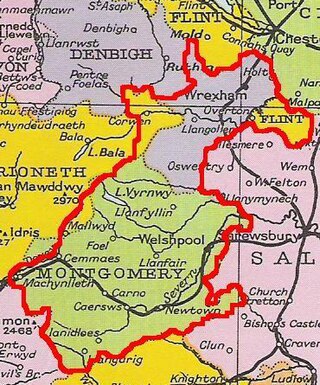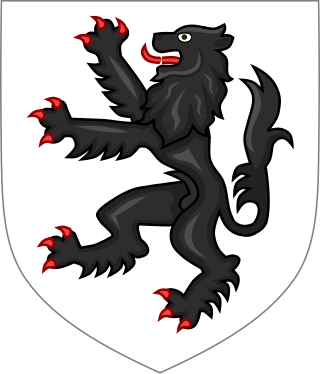
Until 1974, Merionethshire or Merioneth was an administrative county in the north-west of Wales, later classed as one of the thirteen historic counties of Wales.

The Kingdom of Powys was a Welsh successor state, petty kingdom and principality that emerged during the Middle Ages following the end of Roman rule in Britain. It very roughly covered the northern two-thirds of the modern county of Powys and part of today's English West Midlands. More precisely, and based on the Romano-British tribal lands of the Ordovices in the west and the Cornovii in the east, its boundaries originally extended from the Cambrian Mountains in the west to include the modern West Midlands region of England in the east. The fertile river valleys of the Severn and Tern are found here, and this region is referred to in later Welsh literature as "the Paradise of Powys".

Madog ap Maredudd was the last prince of the entire Kingdom of Powys, Wales and for a time held the Fitzalan Lordship of Oswestry.

Powys Fadog was the northern portion of the former princely realm of Powys.

Powys Wenwynwyn or Powys Cyfeiliog was a Welsh kingdom which existed during the high Middle Ages. The realm was the southern portion of the former princely state of Powys which split following the death of Madog ap Maredudd of Powys in 1160: the northern portion (Maelor) went to Gruffydd Maelor and eventually became known as Powys Fadog; while the southern portion (Cyfeiliog) going to Owain Cyfeiliog and becoming known, eventually, as Powys Wenwynwyn after Prince Gwenwynwyn ab Owain, its second ruler.
John "Wynn" ap Maredudd was a Welsh Member of Parliament.
Gruffydd Maelor II was Prince of Powys Fadog.
Sir Gruffudd Vychan, also spelt in English sources as Griffith Vaughan, was a Welsh knight who supported the rebellion of Prince Owain Glyndŵr against the English, and captured the Lollard John Oldcastle, who was later immortalized by Shakespeare as John Falstaff. He was finally executed after the murder of Sir Christopher Talbot, son of John Talbot, 1st Earl of Shrewsbury.
This article is about the particular significance of the century 1201–1300 to Wales and its people.
This is a list of Sheriffs of Merionethshire. The historic county of Merioneth was originally created in 1284. The administrative county of Merioneth was created from the historic county under the Local Government Act 1888.

Baron of Cymmer-yn-Edeirnion, in the county of Merioneth, is a dormant title used by the senior male-line descendants of King Owain Brogyntyn, youngest son of Madog ap Maredudd, King of Powys. Owain Brogyntyn divided his lands equally between his three sons on his death, and his eldest son, Iorwerth, inherited lands centred on Cymmer, in the parish of Llangar and commote of Edeirnion. His son, Gruffydd ab Iorwerth, fought against Edward I during his invasion of Wales. After the Conquest of Wales, Gruffydd came "into the King's peace", and on 22 July 1284, had his lands confirmed by Edward I per baroniam, 'just as his ancestors had held them', thereby creating him a baron in the English feudal baronage. The first surviving use of the title was by Gruffydd's grandson, Owain, who in 1334 was summoned to the sessions at Harlech as Owenus ap Davidus,Dominus de Kimmer. Some authorities, therefore, date the barons from Owain, whereas others begin with Gruffydd. In the fifteenth century their principal residence was known as Plas o Cymmer, and was later renamed Plas Uchaf. Later the 10th Baron moved to the nearby mansion of Gwerclas.

Hughes of Gwerclas were a native Welsh royal family descended from prince Owain Brogyntyn the illegitimate but acknowledged son of prince Madog ap Maredudd by a daughter of the "Maer du" or "black mayor" of Rûg in Edernion. His father granted to him and his successors the Cantref of Edeyrnion and the Lordship of Dinmael. These areas were both remote frontier lands situated between Powys and the neighbouring ascendant Kingdom of Gwynedd. From the earlier part of the 12th Century both lordships usually paid homage to Gwynedd.

Owain Brogyntyn ap Madog was prince of Powys and the third and illegitimate son of king Madog ap Maredudd, the last king of a united Kingdom of Powys. He was the son of Madog by the daughter of the Maer du or "black mayor" of Rûg in Edeyrnion however some sources cite his mother as Susanna making him legitimate instead. He was the brother of Gruffydd Maelor the ancestor of Owain Glyndŵr. Presumably Owain Brogyntyn would have been raised by his mother at Rûg in Edeyrnion. He was acknowledged by his father and granted by him the lordship of Edeyrnion and also Dinmael. It is quite possible that he inherited some of these lands through his maternal grandfather, the Maer Du, which were confirmed and perhaps extended by his father the king of Powys. At some point he also came into possession of Castle Brogyntyn on the English borders at Selattyn close to Oswestry.

The Royal House of Mathrafal began as a cadet branch of the Welsh Royal House of Dinefwr, taking their name from Mathrafal Castle. They effectively replaced the House of Gwertherion, who had been ruling the Kingdom of Powys since late Roman Britain, through the politically advantageous marriage of an ancestor, Merfyn the Oppressor. King Bleddyn ap Cynfyn would join the resistance of the Anglo-Saxon King Harold Godwinson, against the invasion of William the Conqueror, following the Norman conquest of England. Thereafter, they would struggle with the Plantagenets and the remaining Welsh Royal houses for the control of Wales. Although their fortunes rose and fell over the generations, they are primarily remembered as Kings of Powys and last native Prince of Wales.

Anwyl of Tywyn are a Welsh family who claim a patrilinear descent from Owain Gwynedd, King of Gwynedd from 1137 to 1170 and a scion of the royal House of Aberffraw. The family motto is: Eryr eryrod Eryri, which translates as "The Eagle of the Eagles of Snowdonia. The family lives in Gwynedd and speak Welsh.
Nathanael Jones, Esq., of Hendwr, Merionethshire, was a Welsh gentleman-poet.

The Jones of Hendwr, and later Faerdref Uchaf, family is a Welsh gentry family from the parish of Llandrillo-yn-Edeirnion, Merionethshire, descended from the 4th Baron of Hendwr. 'Yr Hendwr' means 'the Old Tower' in Welsh and is visually represented by the crest of the Jones of Hendwr family.
Giwn Lloyd, 18th Baron of Hendwr (1699–1774) and squire of Tyfos, in the county of Merioneth and of Gwersyllt Park and Plas Newydd, in the county of Denbigh, was a Welsh gentleman who lived in the 18th century and was notorious for his dissolute life. He is best remembered for the lengthy court battle which ensued after his death, lasting over twenty years, exhausting the finances of many of his kinsmen, and shocking much of Welsh society.

Ellis ap Griffith (c.1440-1489) or Elissau ap Gruffudd, was the Baron of Gwyddelwern in Denbighshire, Wales, and the grandnephew of Owen Glendower, Prince of Wales. Following his family defeat during the Glyndwr Rising, his branch inherited the co-representation of the Royal House of Mathrafal, and were immortalized by William Shakespeare in the history play Henry IV. Through his mother Lowrie, he inherited the lordship of his grandfather, Tudor Glendower, and by marriage, the estate of Plas-yn-Yale. By this union, he became the founder of the House of Yale, represented by the Yale family, later known in America as the benefactors of Yale University.











